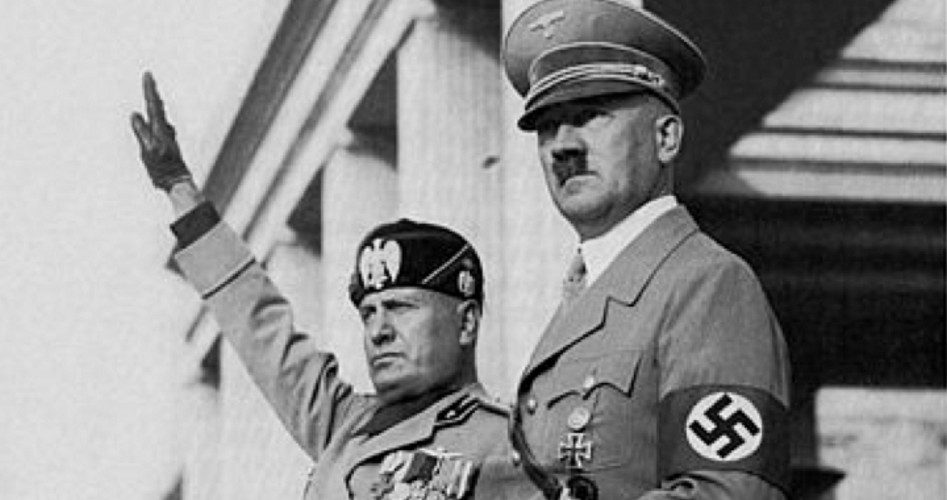
In an article earlier this month, the online Huffington Post mocked the Drudge Report for posting pictures of Adolf Hitler (shown on right, with Benito Mussolini) and Josef Stalin above the headline: “White House Threatens ‘Executive Orders’ on Guns.”
A Google search using the search term “Obama Hitler Gun Control” delivers nearly six million results.
While such evidence is certainly not scientific, it does reveal an increase in the interest of the role of the disarmament of a citizenry in the development of a fascist regime. If one can identify these milestones on the road to the Third Reich, for example, perhaps similar steps can be avoided in the United States of America.
There are those, of course, who hold to the belief that a reduction in arms is progress. President Obama said as much after his recent meeting with police chiefs regarding local enforcement of forthcoming gun control measures.
Not surprisingly, some of those advocates of an unarmed society have sat on the bench of the nation’s highest court.
In 1972, in the case of Adams v. Williams, Justice William O. Douglas wrote a dissenting opinion stating, “There is no reason why pistols should not be barred to everyone except the police.”
There is one glaring reason that should be obvious to a trained jurist. The Second Amendment to the United States declares, “A well regulated Militia, being necessary to the security of a free State, the right of the people to keep and bear Arms, shall not be infringed.” This right historically has been the right that protects all others. An armed populace is recognized as the most significant ally of liberty in its conflict with tyranny.
As Adolf Hitler himself explained, “The most foolish mistake we could possibly make would be to allow the subject races to possess arms. History shows that all conquerors who have allowed their subject races to carry arms have prepared their own downfall by so doing.”
Regardless of the historical importance of the right to bear arms and the identification of disarmament by one of history’s most notorious dictators as critical to conquering a people, there are those who will instantly dismiss comparisons between President Obama’s promised gun control executive orders and Hitler’s murderous rampage through Europe.
Take for example this paragraph from a Policy Mic article published earlier this month:
The use of executive orders will likely spur gun owners to even greater opposition to the White House and increase the number of activists comparing the President to dictators like Hitler or Stalin. As Media Matters analyst Eric Boehlert recently commented, the gun debate draws together two far-right “paranoid fantasies”: the first that Obama is just like Hitler, ready to force Americans into a fascistic or Stalinist state (or “both, if the rhetorician feels no obligation to historical accuracy”), the other that Americans need an unrestricted supply of heavy armaments to fight their “looming insurrectionist war with the government.”
Such attacks are transparent attempts to poison the well and prevent the impressionable from searching the historical record for themselves.
A more journalistic and dispassionate piece might present some of the gun control laws passed in Germany before and during Hitler’s reign of terror.
Such a survey is the purpose of this article. If there are similarities between German disarmament laws that cleared the way for the seizure of absolute power by the Nazi party and contemporary American gun control proposals, they will become apparent to the reader, regardless of personal prejudices or predetermined outcome.
First, in 1919 (about nine years before the rise of the National Socialists), the German post-World War I government passed the Verordnung des Rates der Volksbeauftragen über Waffenbesitz (Regulations of the Council of the People’s Delegates on Weapons Possession). A reaction to the increasing presence of communists in Germany, this gun control law mandated, “All firearms, as well as all kinds of firearms ammunition, are to be surrendered immediately.” Anyone who was found in possession of a gun or ammunition could be punished by up to five years imprisonment and a fine of 100,000 marks.
As agents of the German military enforced this law throughout Germany, in order to accelerate the seizure of all weapons and ammunition, the decision was made to install what might be called in modern political parlance a “Disarmament Czar.” Call for a gun control czar. Sound familiar?
On August 7, 1920, the German government passed the Gesetz über die Entwaffnung der Bevölkerung (Law on the Disarmament of the People). This law created the office of Reichskommissar for Disarmament of the Civil Population. This official was tasked with making a list of “military weapons” that were subject to immediate seizure. Sound familiar?
Perhaps the most frightening and foreboding provision of the law was that requiring all citizens with knowledge of anyone hoarding ammo or who owned outlawed weapons to turn in to the Reichskommissar the names of these people. Neighbors spying on neighbors. Sound familiar?
The next step in the complete disarmament of Germany prior to Hitler’s wresting of absolute power was the passage in 1928 of the Gesetz über Schußwaffen und Munition (Law on Firearms and Ammunition). This law required licensing of anyone who manufactured, assembled, or repaired firearms and ammunition. This included private citizens who reloaded their own rounds. Trade and sale of arms and ammo was also forbidden without a license, including at gun shows and competitive shooting events. Sound familiar?
The license to own a weapon provided for in the 1928 law was called a Waffenschein. This carry license was issued at the will of the government, and an applicant was required to show that his “reliability is not in doubt” and that he had a particular need for a firearm. Psychological testing for a gun license. Sound familiar?
Further, this law placed caps on the types and numbers of weapons and ammunition that could be owned, even by those with licenses. Persons who owned more than five guns or more than 100 rounds of ammunition would have to seek a special license for such an “arsenal.” Caps on ammo. Sound familiar?
Progressive? The disarmament of the population certainly did progress rapidly. As legal scholar Stephen Halbrook wrote in an extraordinarily thorough article published in 2000 in the Arizona Journal of International and Comparative Law:
Within a decade, Germany had gone from a brutal firearms seizure policy which, in times of unrest, entailed selective yet immediate execution for mere possession of a firearm, to a modern, comprehensive gun control law. Passed by a liberal republic, this law ensured that the police had records of all firearms acquisitions (or at least all lawful ones) and that the keeping and bearing of arms were subject to police approval. This firearms control regime was quite useful to the new government that came to power a half decade later.
On March 23, 1933, the Reichstag (German parliament) passed, by a vote of 441 to 94, a measure called the Enabling Act permitting Hitler to make laws without consulting the Reichstag. The president issuing decrees without consulting Congress. Sound familiar?
Finally, within a week of assuming autocratic control of the lawmaking power in Germany, Hitler issued the following order regarding gun ownership:
The units of the national revolution, SA, SS, and Stahlhelm, offer every German man with a good reputation the opportunity to join their ranks for the fight. Therefore, whoever does not belong to one of these named units and nevertheless keeps his weapon without authorization or even hides it, must be viewed as an enemy of the national government and will be held responsible without hesitation and with the utmost severity.
And, in case there were any doubts about the seriousness of the severity, a newspaper entry announcing the edict informed citizens: “If we find military weapons or ammunition after 31 March 1933, we will be forced to proceed ruthlessly.”
This brief, irrefutable recitation of the “progress” of German gun control laws and executive orders demonstrates that there is more than just incidental similarity and that the fear of future firearms seizures by the government is historically sound and not just “paranoid fantasies” of the far-right.
Joe A. Wolverton, II, J.D. is a correspondent for The New American and travels frequently nationwide speaking on topics of nullification, the NDAA, and the surveillance state. He can be reached at [email protected].



